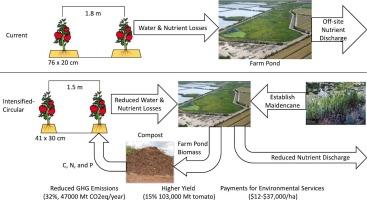Field-to-farm redesign for tomato production to economically mitigate climate change and improve water sustainability
IF 8
1区 环境科学与生态学
Q1 ENVIRONMENTAL SCIENCES
引用次数: 0
Abstract
We present a combination of field-scale sustainable intensification and end-of-farm circular practices to economically mitigate climate change and improve water sustainability of fresh tomato farms. The field-scale practices redesign the conventional geometry of plasticulture to a compact bed (2–10 cm taller, 10–35 cm narrower) to increase input use efficiency. Life cycle assessment showed that compact bed geometry reduced GHG emissions by 6.7 %–11.4 %, and reduced input costs by 5.7 %–12.0 % per kg tomato. The reduced width from compact beds creates extra space between beds allowing more tomato per area, intensifying the system. The intensified field design reduced the GHG emissions by 2.5 % for all bed geometries, with no impact on costs, while increasing land productivity by 15 %. To increase the nutrient circularity of the system, biomass from the end-of-farm detention ponds can be harvested, composted, and applied to the fields as an organic amendment, termed harvesting-composting. Harvesting-composting decreased GHG emissions by 4–21 %, depending on the vegetation. When compact beds, intensified field design, and harvesting-composting are combined, this intensified-circular system reduces GHG emissions by up to 32 % enabling the fresh tomato industry to meet 72 % of the 2030 US GHG reduction target and 75 % of the 2030 target set by the Paris Climate Accord. The intensified system reduces irrigation volume though increased use efficiency while reducing runoff/drainage volume by decreasing the plastic-covered impervious area. When circularity is added, it increases the treatment of nitrogen and phosphorus before leaving the farm. To enable the adoption of the intensified-circular system, payments for environmental services for improving water quality, sequestering carbon, and producing more sustainable products were evaluated, and all but the carbon-based payment was significant enough to be economically feasible. The intensified-circular system has the potential to reduce 47,530 Mt. of CO2eq and increase farm revenue up to $186 million per year for the US tomato industry.

从田间到农场的番茄生产重新设计,以经济地缓解气候变化,提高水的可持续性
我们提出了田间规模的可持续集约化和农场末端循环实践的结合,以经济地缓解气候变化,提高新鲜番茄农场的水可持续性。田间规模的实践将传统的塑料栽培几何结构重新设计为一个紧凑的床(高2-10厘米,窄10-35厘米),以提高投入的使用效率。生命周期评估表明,紧凑的床型结构每公斤番茄减少了6.7% - 11.4%的温室气体排放,降低了5.7% - 12.0%的投入成本。紧凑种植床的宽度减小,在床与床之间创造了额外的空间,每个区域可以种植更多的番茄,从而强化了种植系统。强化的现场设计在不影响成本的情况下,将所有床层的温室气体排放量减少了2.5%,同时将土地生产力提高了15%。为了增加系统的营养循环,可以收获来自农场末端滞留池的生物质,堆肥,并作为有机改良剂应用于田地,称为收获堆肥。收获-堆肥减少了4 - 21%的温室气体排放,这取决于植被。将紧凑的种植床、集约化的田间设计和收获-堆肥相结合,这种集约化循环系统可减少高达32%的温室气体排放,使新鲜番茄产业能够实现美国2030年温室气体减排目标的72%和巴黎气候协议设定的2030年目标的75%。集约化系统通过提高使用效率来减少灌溉量,同时通过减少塑料覆盖的不透水区域来减少径流/排水量。当循环增加时,它在离开农场之前增加了对氮和磷的处理。为了采用强化循环系统,对改善水质、固碳和生产更可持续产品的环境服务支付进行了评估,除了基于碳的支付外,其他所有支付都足够重要,在经济上是可行的。强化循环系统有可能减少47,530亿吨二氧化碳当量,并为美国番茄产业每年增加高达1.86亿美元的农业收入。
本文章由计算机程序翻译,如有差异,请以英文原文为准。
求助全文
约1分钟内获得全文
求助全文
来源期刊

Science of the Total Environment
环境科学-环境科学
CiteScore
17.60
自引率
10.20%
发文量
8726
审稿时长
2.4 months
期刊介绍:
The Science of the Total Environment is an international journal dedicated to scientific research on the environment and its interaction with humanity. It covers a wide range of disciplines and seeks to publish innovative, hypothesis-driven, and impactful research that explores the entire environment, including the atmosphere, lithosphere, hydrosphere, biosphere, and anthroposphere.
The journal's updated Aims & Scope emphasizes the importance of interdisciplinary environmental research with broad impact. Priority is given to studies that advance fundamental understanding and explore the interconnectedness of multiple environmental spheres. Field studies are preferred, while laboratory experiments must demonstrate significant methodological advancements or mechanistic insights with direct relevance to the environment.
 求助内容:
求助内容: 应助结果提醒方式:
应助结果提醒方式:


